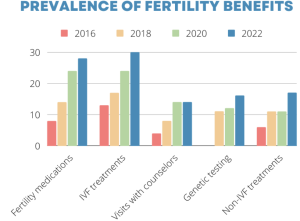In recent years, fertility benefits have transitioned from niche perks to essential components of comprehensive employee benefits packages.
This shift underscores the broader understanding of family planning and personal health needs, but also reflects an evolving workplace culture that values inclusivity, family and support.
For HR professionals, this trend presents a unique opportunity to enhance employee satisfaction, retention, and overall workplace morale by integrating fertility benefits into the total rewards package.
But there are also issues that need to be carefully thought about too.
Current trends in fertility benefits

Source: Pew Research

Source: International Foundation of Employee Benefits Plans
To understand how best fertility benefits needs to be integrated, we first need to understand more about how they have developed.
The adoption of fertility benefits has been driven by several key factors, including increasing awareness about reproductive health, the desire to attract and retain top talent, as well as the push for more inclusive workplace policies.
Companies too are recognizing that traditional health insurance plans often fall short when it comes to covering fertility treatments and related services.
Fertility benefits have a profound impact on employee morale and workplace culture.
By offering these benefits, companies demonstrate a commitment to employee physical, emotional and financial well-being and inclusivity.
This can foster a positive work environment where employees feel valued and supported.
Moreover, such benefits can enhance workplace culture by aligning with broader organizational values around supporting employee’s family building goals as well as diversity, equity, and inclusion.
When employees see that their employer is invested in supporting their personal and family-related needs, it reinforces a sense of loyalty and belonging.
A recent survey found that 88% of employees would switch jobs to obtain fertility coverage, and 61% who already have access are more loyal to their companies and experience improved workplace culture.
Additionally, societal changes, such as delayed family planning, social awareness to fertility challenges, and the diverse family structures within modern workplaces, are contributing to the heightened demand.
Companies are acknowledging that employees might need support with fertility preservation, like egg freezing, in vitro fertilization (IVF), and other fertility treatments.
Integration strategies for HR
Comprehensive fertility support is now critical in a comprehensive employee benefits package.
But implementing fertility benefits requires careful planning and strategic execution.
Here are practical steps HR professionals need to consider:
- Assessing coverage options: Traditional insurance plans may not include comprehensive fertility benefits. HR professionals should evaluate whether to offer these benefits through a “carve-out” option or by partnering with a third-party benefits manager who specializes in fertility services. A carve-out involves adding fertility coverage to the existing insurance plan, whereas a third-party provider can offer a more tailored approach.
- Determining coverage levels: It’s crucial to decide on the extent of coverage to offer. Options range from basic support, such as egg freezing, to a full suite of benefits that includes IVF cycles, medication, and counseling. Medication costs can be a significant barrier to treatment, so including this in the benefits package can make a considerable difference for employees.
- Budgeting considerations: Work with a knowledgeable provider to estimate costs and potential utilization. This will help determine the most effective level of benefits based on your organization’s budget and employee demographics. Balancing costs with comprehensive coverage is key to successful implementation.
- Inclusive benefits: Remember that fertility benefits should cater to a diverse employee base. Fertility benefits are not just for your employees in their 20s. Spouses, partners, and LGBTQIA+ employees may all utilize these benefits, so ensure that the coverage is inclusive and addresses the needs of various family-building goals.
- Employee education: Effective communication is crucial for the successful adoption of fertility benefits. Provide educational resources and ensure employees understand how to access and utilize the benefits. Partner with a third-party benefits manager who offers turnkey communication solutions to facilitate this process.
The future of fertility benefits
Looking ahead, fertility benefits are likely to continue evolving.
Emerging trends include expanded coverage options, such as support for genetic testing and alternative reproductive technologies.
Companies might also see an increase in demand for benefits that address the mental health aspects of fertility challenges.
Conclusions
As more organizations adopt and refine their fertility benefits, there will be a growing focus on personalized and flexible options.
The future of fertility benefits will likely be characterized by an emphasis on customization, allowing employees to tailor their benefits to their specific needs and circumstances.
The rise of fertility benefits in the workplace is more than a trend; it reflects a fundamental shift towards more inclusive and supportive employee benefits.
For HR professionals, integrating these benefits requires thoughtful planning and execution and offers substantial rewards in terms of employee satisfaction and retention.
By considering coverage options, budget, total rewards, and communication, HR professionals can successfully implement fertility benefits that enhance workplace morale and support employees’ family-building goals.
As the landscape continues to evolve, staying informed and adaptable will ensure that your organization remains at the forefront of this important development in employee benefits.
